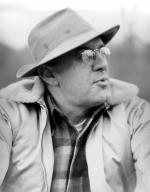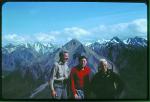![header=[Marker Text] body=[Conservationist and architect of the National Wilderness Preservation System Act of 1964. Although he died four months before President Lyndon Johnson signed the bill his efforts led to the preservation of over 100 million acres across the nation. Zahniser was born in Franklin, Pa., and Tionesta became his hometown. An advocate for preserving wilderness area, he was executive director of The Wilderness Society & editor of its journal. ] sign](http://explorepahistory.com/kora/files/1/10/1-A-142-139-ExplorePAHistory-a0a5i0-a_450.gif)
Mouse over for marker text
Name:
Howard Zahniser
Region:
Allegheny National Forest Region
County:
Forest
Marker Location:
Route 62 just North of Tionesta
Dedication Date:
August 13, 2001
Behind the Marker
When Howard Zahniser quit his job as a federal biologist to become executive secretary of the Wilderness Society in 1945, it was a tiny organization with a membership of only a few hundred. Founded a decade earlier by Forest Service manager Bob Marshall to protect wild and scenic areas against "the tyrannical ambition of civilization to conquer every niche on the whole earth," the Wilderness Society had drawn together some of the nation's leading defenders of wilderness preservation. During the economic boom that followed the end of the Second World War, however, the crusade had little popular support.
For the next decade, Zahniser oversaw membership drives, organized meetings, lobbied in Congress and edited Living Wilderness, the magazine that kept members informed of new threats to national wilderness areas.
"We are part of the wilderness of the universe," Zahniser would tell members of the Sierra Club at its second annual Wilderness Conference in 1951. "That is our nature. Our noblest, happiest character develops with the influence of wildness. Away from it we degenerate into the squalor of slums of the frustration of clinical couches. With the wilderness we are home."
That year, the Wilderness Society and other defenders of America's embattled wilderness areas became engaged in one of the most important preservation battles of the twentieth century. The Bureau of Land Reclamation and western politicians wanted to dam the Colorado River at Echo Park and flood spectacular canyons and rivers in the Dinosaur National Monument in western Colorado. To American preservationists, this violation of the national park system threatened the very foundations of wilderness protection in the United States. In a five-year battle, the underdog environmental forces won.
Concerned by the endless assaults on wilderness areas, Zahniser recognized the need for a more permanent system of protections. In 1956, he wrote the first draft of a federal law "to secure for the American people of present and future generations the benefits of an enduring resource of wilderness." For the next eight years, Zahniser used his skills of diplomacy and persuasion to build support in Congress. The bill faced fierce opposition from developers, western industrialists, conservative members of Congress and even from members of the Wilderness Society. The bill went through sixty-six drafts before it was passed and signed into law by President Lyndon Johnson in late 1964. Zahniser, however, would never see the fruition of his many years of effort, having died of a heart attack the summer before. In 2013, the 757 wilderness areas of the National Wilderness Preservation System included more than 109 million acres in 44 states and Puerto Rico, covering more than 5 percent of the nation's land.
Born in Franklin, Venango County, Zahniser grew up in Tionesta, a small town in Forest County, where he had first fallen in love with the woods and the Allegheny River that flowed near the family's house on Bridge Street. Throughout his life, Zahniser would return to Tionesta to hike, take his family on canoe trips and commune with nature. After his death, his family buried him thirty feet from the river that he loved so dearly. It was not until 1984 that Pennsylvania won its own federally protected wilderness areas-- the Hickory Creek Wilderness Area (8,663 acres) and Allegheny Islands Wilderness Area (368 acres)-- both located in the Allegheny National Forest.
Allegheny River that flowed near the family's house on Bridge Street. Throughout his life, Zahniser would return to Tionesta to hike, take his family on canoe trips and commune with nature. After his death, his family buried him thirty feet from the river that he loved so dearly. It was not until 1984 that Pennsylvania won its own federally protected wilderness areas-- the Hickory Creek Wilderness Area (8,663 acres) and Allegheny Islands Wilderness Area (368 acres)-- both located in the Allegheny National Forest.
I believe that at least in the present phase of our civilization we have a profound, a fundamental need for areas of wilderness - a need that is not only recreational and spiritual but also educational and scientific, and withal essential to a true understanding of ourselves, our culture, our own natures,  and our place in all nature.
and our place in all nature.
Howard Zahniser, “The Need for Wilderness Areas,” 1956
Howard Zahniser, “The Need for Wilderness Areas,” 1956
When Howard Zahniser quit his job as a federal biologist to become executive secretary of the Wilderness Society in 1945, it was a tiny organization with a membership of only a few hundred. Founded a decade earlier by Forest Service manager Bob Marshall to protect wild and scenic areas against "the tyrannical ambition of civilization to conquer every niche on the whole earth," the Wilderness Society had drawn together some of the nation's leading defenders of wilderness preservation. During the economic boom that followed the end of the Second World War, however, the crusade had little popular support.
For the next decade, Zahniser oversaw membership drives, organized meetings, lobbied in Congress and edited Living Wilderness, the magazine that kept members informed of new threats to national wilderness areas.
"We are part of the wilderness of the universe," Zahniser would tell members of the Sierra Club at its second annual Wilderness Conference in 1951. "That is our nature. Our noblest, happiest character develops with the influence of wildness. Away from it we degenerate into the squalor of slums of the frustration of clinical couches. With the wilderness we are home."
That year, the Wilderness Society and other defenders of America's embattled wilderness areas became engaged in one of the most important preservation battles of the twentieth century. The Bureau of Land Reclamation and western politicians wanted to dam the Colorado River at Echo Park and flood spectacular canyons and rivers in the Dinosaur National Monument in western Colorado. To American preservationists, this violation of the national park system threatened the very foundations of wilderness protection in the United States. In a five-year battle, the underdog environmental forces won.
Concerned by the endless assaults on wilderness areas, Zahniser recognized the need for a more permanent system of protections. In 1956, he wrote the first draft of a federal law "to secure for the American people of present and future generations the benefits of an enduring resource of wilderness." For the next eight years, Zahniser used his skills of diplomacy and persuasion to build support in Congress. The bill faced fierce opposition from developers, western industrialists, conservative members of Congress and even from members of the Wilderness Society. The bill went through sixty-six drafts before it was passed and signed into law by President Lyndon Johnson in late 1964. Zahniser, however, would never see the fruition of his many years of effort, having died of a heart attack the summer before. In 2013, the 757 wilderness areas of the National Wilderness Preservation System included more than 109 million acres in 44 states and Puerto Rico, covering more than 5 percent of the nation's land.
Born in Franklin, Venango County, Zahniser grew up in Tionesta, a small town in Forest County, where he had first fallen in love with the woods and the







